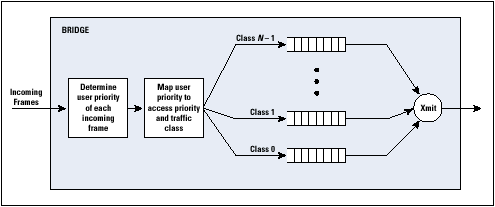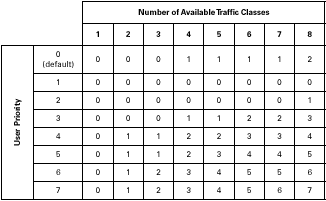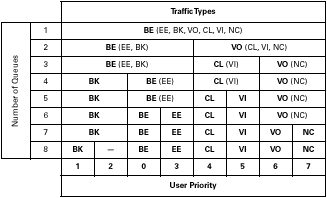 |
A frame that must go through a bridge has already suffered more delay than a frame that does not have to go through a bridge;
therefore, we may wish to give such a frame a higher access priority than the requested user priority.
|
 |
It is important that the bridge not become a bottleneck. Therefore, we may wish to give all frames being transmitted by a
bridge a relatively high priority.
|
 |
User priority : The user priority is a label carried with the frame that communicates the requested priority to
downstream nodes (bridges and end systems). Typically, the user priority is not modified in transit through bridges, unless a
mapping is needed for the use of a different number of priority levels by different MAC types. Thus, the user priority has
end-to-end significance across bridged LANs.
|
 |
Access priority : The access priority is used, on LANs that support priority, to compete for access to the shared
LAN with frames from other devices (end systems and other bridges) attached to the same LAN. For example, the token-passing
discipline in a Token Ring network enables higher-priority frames to gain access to the ring ahead of lower-priority frames
when frames from multiple stations are waiting to gain access. When both the incoming and outbound LAN are of the same MAC
type, the bridge assigns an access priority equal to the incoming user priority. Otherwise, the bridge must perform a mapping
as defined in Table 1.
|
 |
Traffic class : A bridge can be configured so that multiple queues are used to hold frames waiting to be transmitted
on a given outbound port, in which case the traffic class is used to determine the relative priority of the queues. All
waiting frames at a higher traffic class are transmitted before any waiting frames of a lower traffic class. As with access
priority, traffic class is assigned by the bridge on the ba-sis of incoming user priority.
|
 |
Queuing delay : The time that a frame waits until it becomes first in line for transmission on the outbound port.
This delay is determined by the queuing discipline used by the bridge. The simplest scheme is first-in, first-out (FIFO).
Traffic classes permit more sophisticated schemes.
|
 |
Access delay : The delay that a frame experiences waiting for permission to transmit on the LAN, in competition with
frames from other stations attached to the same LAN. This delay is determined by the MAC protocol used (for example Token
Ring, Carrier Sense Multiple Access Collision Detect [CSMA/CD]).
|
| 1. |
A frame may be transmitted from a queue only if all queues corresponding to numerically higher values of traffic class are
empty. For example, if there is a frame in queue 0, it can be transmitted only if all the other queues at that port are
currently empty.
|
| 2. |
Within a given queue, the order of frame transmission must satisfy the following: The order of frames received by this bridge
and assigned to this outbound port shall be preserved for:
 |
Unicast frames with a given combination of destination address and source address
|
 |
Multicast frames for a given destination address
|
|
| 1. |
The mapping is based on the user priority associated with the frame, which, as was mentioned earlier, has end-to-end
significance. However, the 802.3 and 802.11 frame formats do not include a priority field, meaning that this end-to-end
information could be lost. To address this issue, the bridge is able to reference the priority field contained in a tag header
defined in IEEE 802.1Q, which deals with virtual LANs. The 802.1Q specification defines a tag header of 32 bits that is
inserted after the source and destination address fields of the frame header. This tag header includes a 3-bit
priority field. Thus, if 802.1Q is in use by Ethernet and wireless LAN sources, a user priority can be defined that stays
with the frame from source to destination.
|
| 2. |
Outbound ports associated with MAC methods that support only a single access priority, such as 802.3 and 802.11, can support
multiple traffic classes. Recall that the traffic class deals with queuing delay, while the access priority deals with access
delay.
|
 |
Network control (7): Both time critical and safety critical, consisting of traffic needed to maintain and support the
network infrastructure, such as routing protocol frames. Voice (6): Time critical, characterized by than 10-ms delay,
such as interactive voice.
|
 |
Voice (6): Time critical, characterized by than 10-ms delay, such as interactive voice.
|
 |
Video (5): Time critical, characterized by less than 100-ms delay, such as interactive video.
|
 |
Controlled load (4): Non-time-critical but loss sensitive, such as streaming multimedia and business-critical traffic.
A typical use is for business applications subject to some form of reservation or admission control, such as capacity
reservation per flow.
|
 |
Excellent effort (3): Also non-time-critical but loss sensitive, but of lower priority than controlled load. This is a
best-effort type of service that an information services organization would deliver to its most important customers.
|
 |
Best effort (2): Non-time-critical and loss insensitive. This is LAN traffic handled in the traditional fashion.
|
 |
Background (0): Non-time-critical and loss insensitive, but of lower priority than best effort. This type includes bulk
transfers and other activities that are permitted on the network but that should not impact the use of the network by
other users and applications.
|
Only seven traffic types are are defined in IEEE 802.1D. The standard leaves as spare an eighth type, which could be used for traffic
of more importance than background but less importance than best effort. The numbers in parentheses in the preceding list are the
traffic-class values corresponding to each traffic type if there are eight queues and hence eight traffic classes available at a
given output port.


















